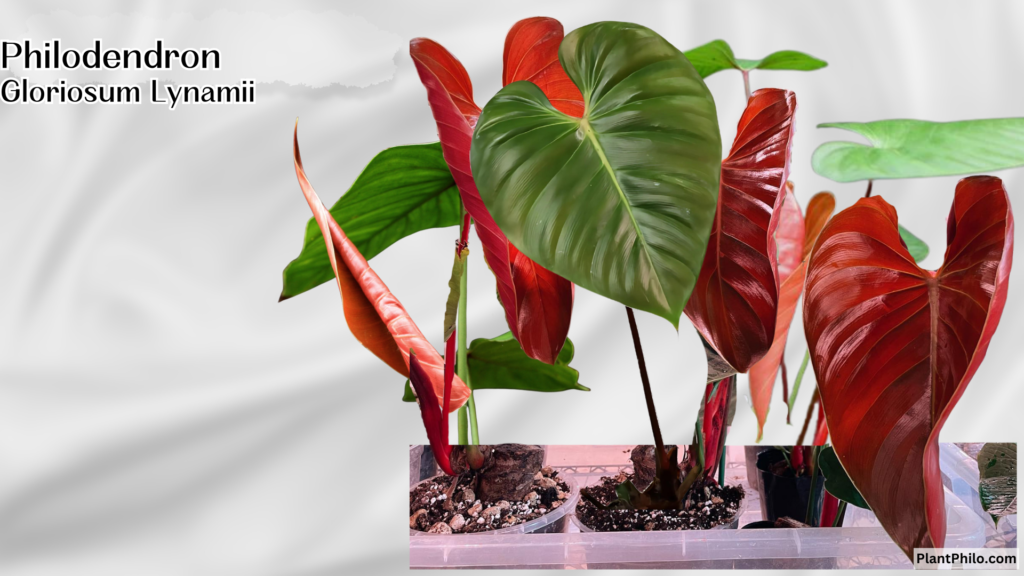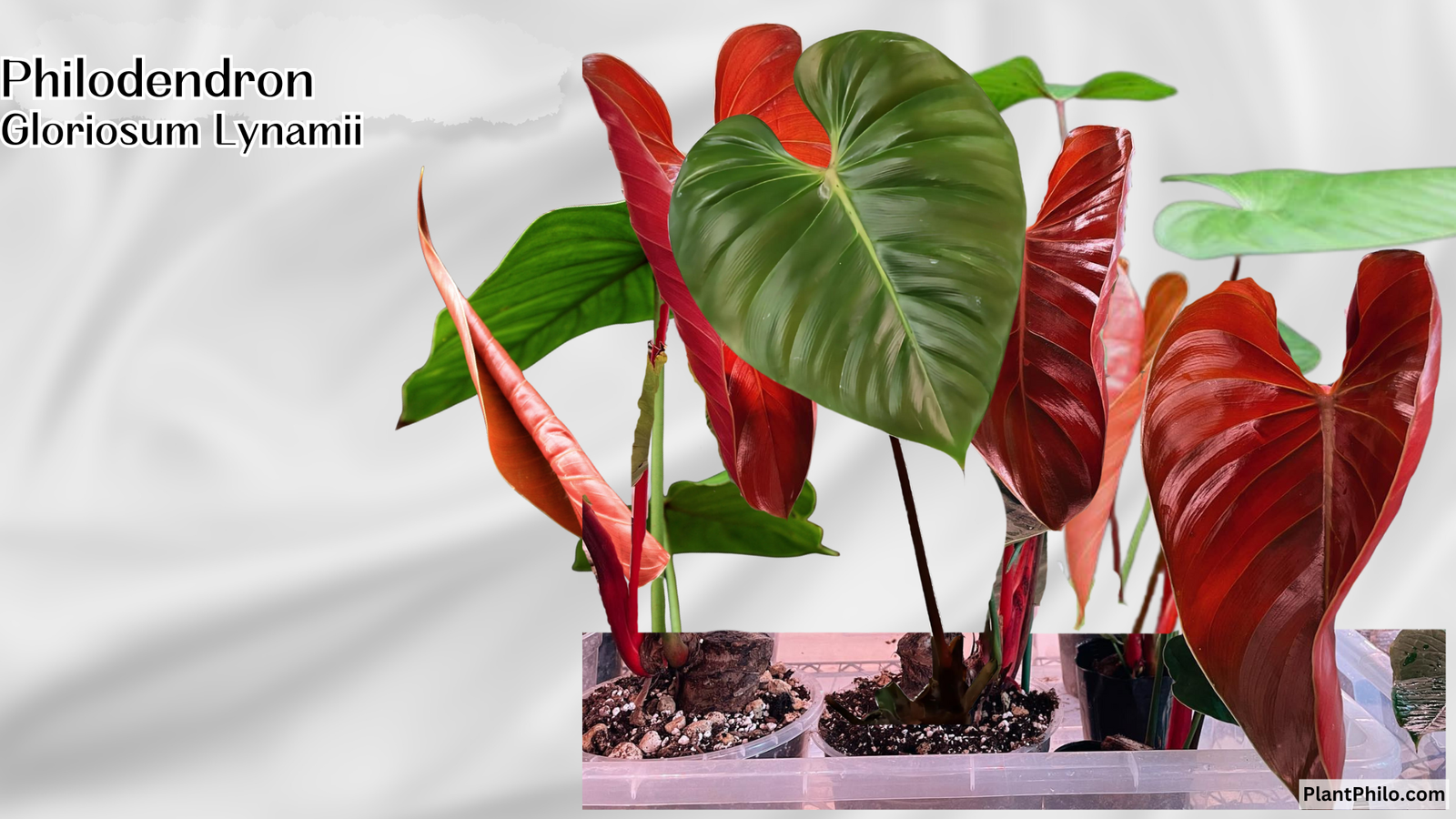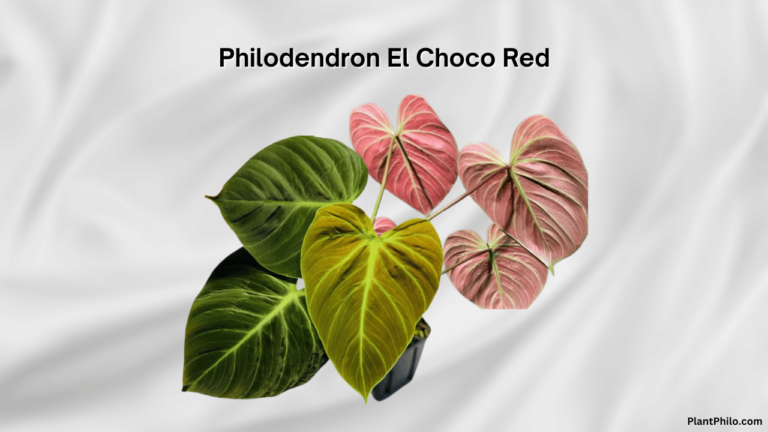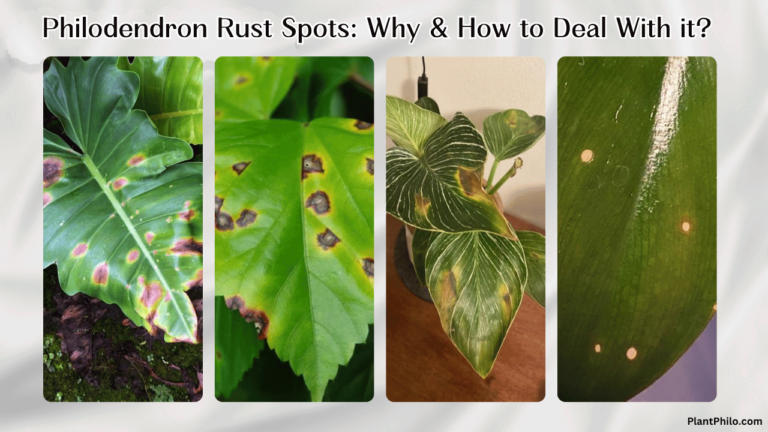Philo Lynamii: A plant with a bold personality & color-changing leaves
Philodendron Lynamii is the plant that’s been causing a stir among aroid enthusiasts and leaving many scratching their heads in confusion.
If you’ve ever found yourself staring at a Lynamii, wondering why your supposedly “easy-care” plant is giving you the cold shoulder, you’re not alone. But fear not, green-thumbed friends, for we’re about to unravel the mysteries of this botanical beauty.
Information Table: Philodendron Lynamii
| Feature | Details |
| Scientific Name | Philodendron lynamii |
| Origin | Tropical rainforests of Ecuador |
| Growth Habit | Vining |
| Leaf Shape | Heart-shaped to elongated, velvety texture |
| Leaf Color | Deep green with a subtle sheen |
| Light Needs | Bright, indirect light |
| Water Needs | Keep soil evenly moist but not soggy |
| Humidity | High humidity (60-80%) |
| Soil | Well-draining, airy mix rich in organic matter |
| Fertilizer | Balanced liquid fertilizer during the growing season |
| Propagation | Stem cuttings |
| Pests & Diseases | Susceptible to common houseplant pests and root rot if overwatered |
| Toxicity | Toxic to pets and humans if ingested |
Philodendron Lynamii

Philodendron Lynamii, a member of the Araceae family, is a climber who hails from the lush rainforests of Ecuador. This plant is like the supermodel of the Philodendron world – stunning to look at, but with a few quirks that keep things interesting.
What sets Lynamii apart from its leafy cousins? It’s all about those leaves, baby! Lynamii sports large, elongated heart-shaped leaves that can grow up to 2 feet long. The leaves start with a reddish-copper hue when young, maturing into a deep, glossy green that would make even the Jolly Green Giant green with envy.
But here’s where it gets really interesting: the leaf undersides. They’re not just green; they’re a work of art. The veins pop with a lighter green color, creating a contrast that’s simply a chef’s kiss. It’s like Mother Nature decided to flex her artistic muscles and went all out on this one.
Lynamii Care: Cracking the Code
Light: Bright but Indirect is the Sweet Spot
Lynamii likes it’s light the way most of us like our summer days – bright but not scorching. In its natural habitat, it grows under the canopy of taller trees, receiving dappled sunlight. To recreate this at home:
- Place your Lynamii near a north or east-facing window.
- If you only have south or west-facing windows, use a sheer curtain to filter the light.
- Avoid direct sunlight, which can scorch the leaves faster than you can say “crispy fried philodendron”.
Water: The Goldilocks Approach
When it comes to watering, Lynamii prefers the “not too much, not too little” approach. Here’s a watering schedule that’s worked wonders for many growers:
- Spring/Summer: Water when the top 1-2 inches of soil feel dry.
- Fall/Winter: Reduce watering frequency, allowing the top 2-3 inches to dry out between waterings.
Pro tip: Use a moisture meter if you’re unsure. Your Lynamii will thank you for not playing guessing games with its hydration needs.
Humidity: Channel Your Inner Rainforest
Lynamii thrives in high humidity, aiming for 60-80%. If you’re not living in a sauna (and let’s face it, most of us aren’t), here are some ways to boost humidity:
- Group plants together (plant party, anyone?)
- Use a pebble tray
- Invest in a humidifier
- Mist the leaves regularly, but avoid overdoing it to prevent fungal issues
Temperature: Keep it Cozy
Your Lynamii likes it warm, preferably between 65-80°F (18-27°C). It’s not a fan of cold drafts or sudden temperature changes, so keep it away from air conditioning vents and drafty windows. Think of it as the Goldilocks of the plant world – not too hot, not too cold, but just right.
Soil: Well-draining is the Name of the Game
A well-draining, airy potting mix is crucial for Lynamii’s happiness. Here’s a mix that’s been a hit with many growers:
- 2 parts orchid bark
- 1 part perlite
- 1 part coconut coir
- 1 part worm castings
This mix provides the perfect balance of moisture retention and drainage, mimicking the plant’s natural habitat. It’s like creating a five-star hotel for your plant’s roots.
Fertilizer: Feed Me, But Don’t Overfeed Me
During the growing season (spring and summer), feed your Lynamii with a balanced, water-soluble fertilizer every 2-4 weeks. Dilute the fertilizer to half-strength to avoid burning the roots. In fall and winter, reduce feeding to once a month or stop altogether.
Remember, over-fertilizing is like force-feeding your plant – it won’t end well for anyone involved.
Propagation: Spread the Lynamii Love
Ready to expand your Lynamii family? Here’s how:
- Stem Cuttings:
- Choose a healthy stem with at least one node and one leaf.
- Cut just below the node using clean, sharp scissors.
- Place the cutting in water or moist sphagnum moss.
- Wait for roots to develop (usually 3-5 weeks).
- Once roots are 2-3 inches long, plant in soil.
- Air Layering:
- Make a small incision on the stem below a node.
- Apply rooting hormone to the wound.
- Wrap the area with moist sphagnum moss and secure with plastic wrap.
- Wait for roots to develop (usually 4-6 weeks).
- Once roots are visible, cut below the rooted area and pot up.
Remember, patience is a virtue when it comes to propagation. Your new Lynamii babies won’t pop up overnight, but the wait is worth it!
Troubleshooting: When Lynamii Throws a Tantrum
Even with the best care, problems can arise. Here’s how to tackle common issues:
- Yellow Leaves: Often a sign of overwatering or poor drainage. Check your watering routine and ensure your pot has drainage holes.
- Brown, Crispy Edges: Usually indicates low humidity or underwatering. Up your humidity game and check your watering routine.
- Leggy Growth: Your plant might need more light. Gradually move it to a brighter spot, but avoid direct sunlight.
- Slow Growth: This is normal in winter. If it’s happening during the growing season, check your light, water, and fertilizer routine.
- Pests: Keep an eye out for spider mites, mealybugs, and scale insects. Treat immediately with neem oil or insecticidal soap.
The Science Behind the Beauty
Philodendron Lynamii, like other aroids, has some fascinating adaptations that make it a superstar in the plant world:
- Aerial Roots: These roots grow from the stem and help the plant climb in its natural habitat. They also absorb moisture and nutrients from the air.
- Cataphylls: These modified leaves protect new leaves as they emerge. They eventually dry up and fall off, leaving behind rings on the stem.
- Fenestrations: While not as pronounced as in some other Philodendrons, Lynamii can develop small splits in its leaves. These are thought to help the plant withstand strong winds and allow light to reach lower leaves.
Lynamii in the Wild
In its natural habitat, Philodendron Lynamii is an epiphyte, meaning it grows on other plants (usually trees) without harming them. It uses its aerial roots to climb up towards the light, often reaching impressive heights.
This climbing behavior is why Lynamii appreciates a moss pole or trellis in home cultivation. It’s not just for looks – it actually helps the plant grow more naturally and can lead to larger, more mature leaves.
The Cultural Significance: From Jungle to Living Room
The popularity of Philodendron Lynamii is part of a larger trend in houseplant enthusiasm. As urban dwellers seek to bring a touch of nature into their homes, unusual plants like Lynamii have become highly sought after.
This trend has both positive and negative implications. On the one hand, it encourages more people to engage with nature and learn about plant care. On the other, it’s putting pressure on wild populations of rare plants. That’s why it’s crucial to only purchase from reputable sources that use ethical propagation methods.
Conservation Considerations
While Philodendron Lynamii isn’t currently listed as endangered, its natural habitat in Ecuador is under threat from deforestation and climate change. By learning to care for these plants in our homes, we’re not just adding beauty to our lives – we’re also becoming stewards of plant biodiversity.
Fun Facts to Impress Your Plant Friends
- The genus name “Philodendron” comes from the Greek words “Philo” (love) and “dendron” (tree), literally meaning “tree hugger” due to their climbing nature in the wild.
- Philodendrons are part of the Araceae family, which includes other popular houseplants like pothos, monstera, and peace lilies.
- In the wild, some philodendron species can grow leaves up to 5 feet long! While Lynamii doesn’t quite reach these sizes, it can still produce impressively large leaves under the right conditions.
- Philodendrons have been shown to have air-purifying qualities, helping to remove indoor air pollutants like formaldehyde.
The Lynamii Lifestyle
Growing a Philodendron Lynamii is more than just a hobby – it’s a lifestyle choice. It’s about bringing a piece of the Ecuadorian rainforest into your home, creating a connection with nature that goes beyond mere decoration.
Caring for a Lynamii teaches patience, observation, and the art of listening to what a plant needs. It’s a reminder that growth takes time, that beauty can be found in the small details, and that sometimes, the most rewarding relationships are the ones that require a little extra care.
Summing Up,
Caring for a Philodendron Lynamii is an adventure. From the thrill of seeing a new leaf unfurl to the satisfaction of mastering its care, this plant offers a unique journey for every grower.
Remember, every plant is unique, and what works for one might not work for another. Don’t be afraid to experiment (within reason) and learn from your plant. After all, that’s half the fun of being a plant parent!
So, are you ready to join the Lynamii club? Get ready for a wild ride filled with lush leaves, aerial roots, and the occasional “What on earth does this plant want from me?” moment. Trust us; it’s all part of the Lynamii charm!
Why are the leaves on my Philodendron Lynamii turning yellow?
Yellowing leaves can indicate overwatering, underwatering, or nutrient deficiencies. Check the soil moisture and adjust your watering accordingly. Consider fertilizing during the growing season if nutrient deficiency is suspected.
How often should I repot my Philodendron Lynamii?
Repot every 1-2 years or when the roots become overcrowded. Spring is the ideal time for repotting.
Can I grow my Philodendron Lynamii outdoors?
Yes, but only in tropical or subtropical climates with high humidity and filtered light. Protect it from direct sunlight and extreme temperatures.
How do I encourage my Philodendron Lynamii to climb?
Provide it with a moss pole, trellis, or other support structure to encourage its natural vining habit.
What are the signs of underwatering in a Philodendron Lynamii?
Wilting or drooping leaves, dry soil, and brown leaf tips can indicate underwatering. Increase the frequency of watering and ensure the soil remains evenly moist.
Can I propagate my Philodendron Lynamii from a leaf cutting?
No, leaf cuttings won’t produce new plants. You need a stem cutting with at least one node for successful propagation.
Why are the new leaves on my Philodendron Lynamii smaller than the older ones?
This could be due to insufficient light, nutrient deficiencies, or the plant adjusting to a new environment. Ensure it receives adequate light and consider fertilizing during the growing season.
Is the Philodendron Lynamii rare?
While not as common as some other Philodendron varieties, it’s becoming more readily available in the plant trade.
Where can I buy a Philodendron Lynamii?
Look for reputable plant sellers specializing in aroids. Online retailers and local nurseries might carry this species.
How fast does the Philodendron Lynamii grow?
With optimal care, it can exhibit moderate to fast growth, especially during the growing season.




